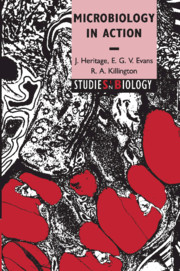Book contents
- Frontmatter
- Contents
- Preface
- 1 The microbiology of soil and of nutrient cycling
- 2 Plant–microbe interactions
- 3 The microbiology of drinking water
- 4 Microbial products
- 5 Food microbiology
- 6 The human commensal flora
- 7 Microbial infections
- 8 Chemotherapy and antibiotic resistance
- Further reading
- Glossary
- Index
3 - The microbiology of drinking water
Published online by Cambridge University Press: 05 June 2012
- Frontmatter
- Contents
- Preface
- 1 The microbiology of soil and of nutrient cycling
- 2 Plant–microbe interactions
- 3 The microbiology of drinking water
- 4 Microbial products
- 5 Food microbiology
- 6 The human commensal flora
- 7 Microbial infections
- 8 Chemotherapy and antibiotic resistance
- Further reading
- Glossary
- Index
Summary
Water is essential for the maintenance of all life on Earth. It also acts as the vector for many diseases caused by bacteria, viruses, protozoa and worms. For water to be regarded as potable, i.e. of a quality fit and safe for drinking, it must be free from such pathogens. Furthermore, it must not contain any other noxious substances such as chemical hazards including pesticides, insecticides or herbicides, artificial fertilisers or heavy metal ions. Potable water should not have an unpleasant odour or taste.
What are water-borne diseases?
Among the bacterial infections that are spread by water are cholera, the enteric fevers and dysentery. Hepatitis A and poliovirus cause infections after drinking contaminated water. Amoebic dysentery is caused by the protozoan Entamoeba histolytica and is spread either by drinking contaminated water or by eating food such as fresh fruit, salad or raw vegetables that have been washed in contaminated water. Other protozoal diseases such as those caused by Giardia intestinalis (Giardia lamblia), Balantidium coli and Cryptosporidium species are spread in a similar fashion. Schistosomiasis, also known as bilharzia, is a water-borne infestation caused by worms of the genus Schistosoma.
Cholera
Cholera is a disease that has been known since ancient times. It was confined to the Indian sub-continent but between 1817 and 1923 there were six pandemics in which cholera spread from its original home across the world. It is now also endemic in South America as well as in Asia.
- Type
- Chapter
- Information
- Microbiology in Action , pp. 36 - 53Publisher: Cambridge University PressPrint publication year: 1999



